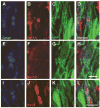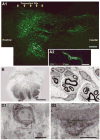Remyelination of the injured spinal cord
- PMID: 17618995
- PMCID: PMC2605400
- DOI: 10.1016/S0079-6123(06)61030-3
Remyelination of the injured spinal cord
Abstract
Contusive spinal cord injury (SCI) can result in necrosis of the spinal cord, but often long white matter tracts outside of the central necrotic core are demyelinated. One experimental strategy to improve functional outcome following SCI is to transplant myelin-forming cells to remyelinate these axons and improve conduction. This review focuses on transplantation studies using olfactory ensheathing cell (OEC) to improve functional outcome in experimental models of SCI and demyelination. The biology of the OEC, and recent experimental research and clinical studies using OECs as a potential cell therapy candidate are discussed.
Figures








Similar articles
-
Olfactory Ensheathing Cell Transplantation after a Complete Spinal Cord Transection Mediates Neuroprotective and Immunomodulatory Mechanisms to Facilitate Regeneration.J Neurosci. 2016 Jun 8;36(23):6269-86. doi: 10.1523/JNEUROSCI.0085-16.2016. J Neurosci. 2016. PMID: 27277804 Free PMC article.
-
Impaired spinal cord remyelination by long-term cultured adult porcine olfactory ensheathing cells correlates with altered in vitro phenotypic properties.Xenotransplantation. 2010 Jan-Feb;17(1):71-80. doi: 10.1111/j.1399-3089.2009.00562.x. Xenotransplantation. 2010. PMID: 20149190
-
Conditioned medium of olfactory ensheathing cells promotes the functional recovery and axonal regeneration after contusive spinal cord injury.Brain Res. 2017 Jan 1;1654(Pt A):43-54. doi: 10.1016/j.brainres.2016.10.023. Epub 2016 Oct 24. Brain Res. 2017. PMID: 27789279
-
Olfactory ensheathing cells: bridging the gap in spinal cord injury.Neurosurgery. 2000 Nov;47(5):1057-69. doi: 10.1097/00006123-200011000-00006. Neurosurgery. 2000. PMID: 11063098 Review.
-
Remyelination after olfactory ensheathing cell transplantation into diverse demyelinating environments.Exp Neurol. 2011 May;229(1):88-98. doi: 10.1016/j.expneurol.2011.01.010. Epub 2011 Jan 28. Exp Neurol. 2011. PMID: 21281634 Review.
Cited by
-
Functional regeneration of the transected recurrent laryngeal nerve using a collagen scaffold loaded with laminin and laminin-binding BDNF and GDNF.Sci Rep. 2016 Aug 25;6:32292. doi: 10.1038/srep32292. Sci Rep. 2016. PMID: 27558932 Free PMC article.
-
Genetic basis of inherited macular dystrophies and implications for stem cell therapy.Stem Cells. 2009 Nov;27(11):2833-45. doi: 10.1002/stem.159. Stem Cells. 2009. PMID: 19551904 Free PMC article. Review.
-
Convergence of cells from the progenitor fraction of adult olfactory bulb tissue to remyelinating glia in demyelinating spinal cord lesions.PLoS One. 2009 Sep 29;4(9):e7260. doi: 10.1371/journal.pone.0007260. PLoS One. 2009. PMID: 19787061 Free PMC article.
-
Scaffold-Mediated Sustained, Non-viral Delivery of miR-219/miR-338 Promotes CNS Remyelination.Mol Ther. 2019 Feb 6;27(2):411-423. doi: 10.1016/j.ymthe.2018.11.016. Epub 2018 Dec 1. Mol Ther. 2019. PMID: 30611662 Free PMC article.
-
Neurophysiological characterization of motor recovery in acute spinal cord injury.Spinal Cord. 2011 Mar;49(3):421-9. doi: 10.1038/sc.2010.145. Epub 2010 Nov 16. Spinal Cord. 2011. PMID: 21079622 Free PMC article.
References
-
- Au E, Roskams AJ. Olfactory ensheathing cells of the lamina propria in vivo and in vitro. Glia. 2003;41:224–236. - PubMed
-
- Bareyre FM, Kerschensteiner M, Raineteau O, Mettenleiter TC, Weinmann O, Schwab ME. The injured spinal cord spontaneously forms a new intraspinal circuit in adult rats. Nat Neurosci. 2004;10:269–277. - PubMed
-
- Barnett SC, Alexander CL, Iwashita Y, Gilson JM, Crowther J, Clark L, Dunn LT, Papanastassiou V, Kennedy PG, Franklin RJ. Identification of a human olfactory ensheathing cell that can effect transplant-mediated remyelination of demyelinated CNS axons. Brain. 2000;123:1581–1588. - PubMed
-
- Basso DM, Beattie MS, Bresnahan JC. A sensitive and reliable locomotor rating scale for open field testing in rats. J Neurotrauma. 1995;12:1–21. - PubMed
-
- Blakemore WF, Crang AJ. The use of cultured autologous Schwann cells to remyelinate areas of persistent demyelination in the central nervous system. J Neurol Sci. 1985;70:207–223. - PubMed
Publication types
MeSH terms
Grants and funding
LinkOut - more resources
Full Text Sources
Medical

